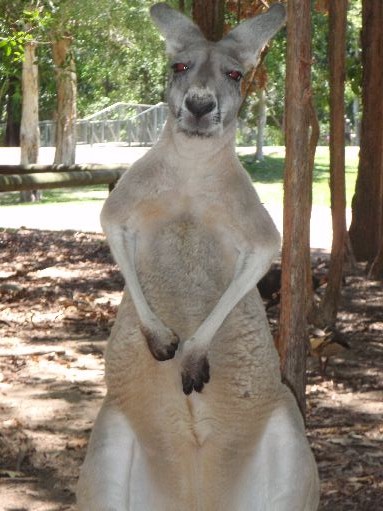Written By:
We’ve had an incredibly busy year. We started out in San Carlos, Mexico and now we’re in Bundaberg, Australia.
From San Carlos we made our way down to La Cruz, a beautiful little town near Puerto Vallarta, to prep for the trip across the Pacific. This was an exciting time for us but we knew that we’d soon be missing Mexico. Wayne’s Mom and Dad visited us there and helped with advice for preparing the boat and storing vast quantities of food and supplies. We eventually reached the end of the list and in mid-March we left for the Marquesas Islands. This is a trip of approximately 3000 nautical miles that took us 22 days. Mostly it was a bit tedious, with the occasional moment of terror thrown in for variety. We ended up doing the last of the trip without our largest headsail after its halyard broke; not a dangerous problem but it slowed us down a bit. Our general feeling about the trip is “the Pacific is really, really big”.
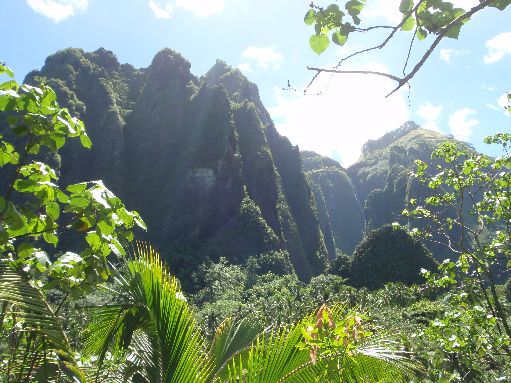 The Marquesas Islands are a remote part of French Polynesia. The islands are incredibly rugged with vertical cliffs rising hundred of feet straight out of the sea, fabulous, lush vegetation and nice people. Unfortunately those cliffs mean that there are not a lot of great harbours and the islands are also home to voracious little sand fleas that have teeth fit for a tiger. The lush vegetation was also a clue to the prodigious amounts of rain that fall there. The place wasn’t without its ‘fleas’ but we enjoyed our time there.
The Marquesas Islands are a remote part of French Polynesia. The islands are incredibly rugged with vertical cliffs rising hundred of feet straight out of the sea, fabulous, lush vegetation and nice people. Unfortunately those cliffs mean that there are not a lot of great harbours and the islands are also home to voracious little sand fleas that have teeth fit for a tiger. The lush vegetation was also a clue to the prodigious amounts of rain that fall there. The place wasn’t without its ‘fleas’ but we enjoyed our time there.
Next stop was the Tuamotu atolls. The group is also called the Dangerous Archipelago because of the low islands and hundreds of low reefs. Pre-GPS this was an extremely difficult place to sail around safely. The Tuamotus have some of the clearest water in the 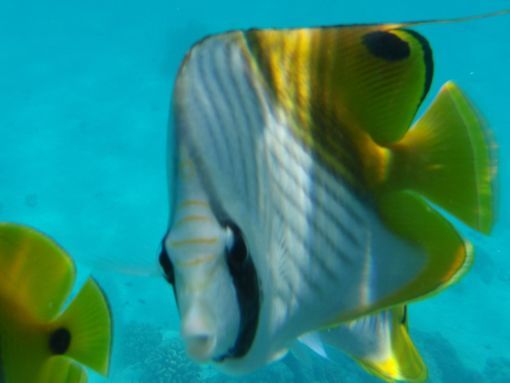
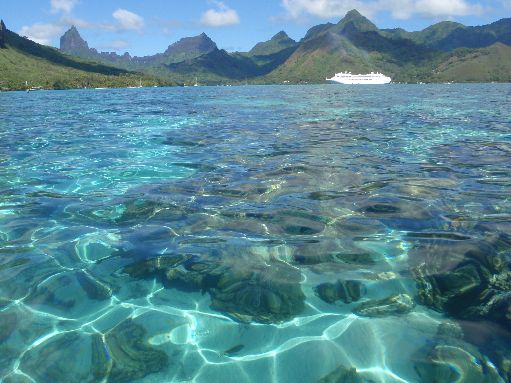 We stopped at Papeete in Tahiti for a few days; it’s pretty much like any big city. The island of Tahiti is quite beautiful although we didn’t explore outside of Papeete. Next we enjoyed a couple weeks on Moorea, which is a truly beautiful island. It has fabulous mountains right to the ocean, white sand beaches, great snorkeling, and fantastic French bread.
We stopped at Papeete in Tahiti for a few days; it’s pretty much like any big city. The island of Tahiti is quite beautiful although we didn’t explore outside of Papeete. Next we enjoyed a couple weeks on Moorea, which is a truly beautiful island. It has fabulous mountains right to the ocean, white sand beaches, great snorkeling, and fantastic French bread.
We had one fascinating snorkel there with sting rays and sharks. The local dive companies feed the sting rays and as a result there are a few dozen that come every day to one small area. We had a couple of hours snorkeling amongst them, even touching them. They feel sort of like your tongue, rough but smooth 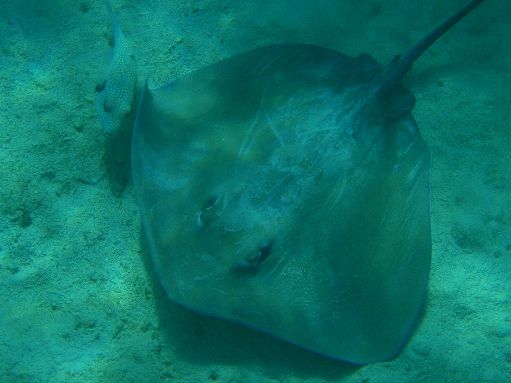 and spongy. I was petting one under the chin when I accidentally put two fingers right in his mouth. He closed his mouth because people all around were feeding them but instantly figured out that he had my fingers rather than food and opened back up. I didn’t even get scratched. These flying, magic carpets had an average wingspan of about five feet. They do have a stinger and yes, we know that one accidentally killed the crocodile guy but they’re not normally dangerous unless they’re threatened. We made a couple more stops in French Polynesia including Huahine and Raiatea and finally Bora-Bora. Bora-Bora was nice but it wasn’t Moorea.
and spongy. I was petting one under the chin when I accidentally put two fingers right in his mouth. He closed his mouth because people all around were feeding them but instantly figured out that he had my fingers rather than food and opened back up. I didn’t even get scratched. These flying, magic carpets had an average wingspan of about five feet. They do have a stinger and yes, we know that one accidentally killed the crocodile guy but they’re not normally dangerous unless they’re threatened. We made a couple more stops in French Polynesia including Huahine and Raiatea and finally Bora-Bora. Bora-Bora was nice but it wasn’t Moorea.
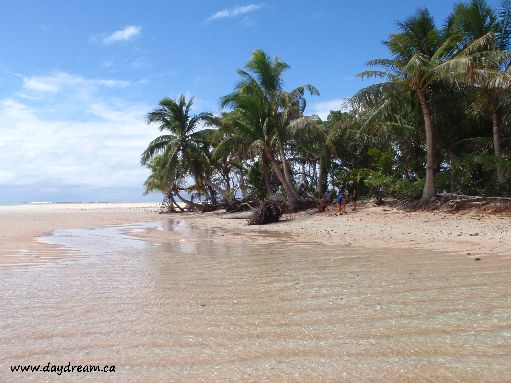 Our next passage took a few days and brought us to the atoll of Suwarrow in the Cook Islands. Suwarrow, also known as Suvarov, is a lovely, isolated atoll that can only be visited by private boat. This was one of our two most favourite places so far in the Pacific; the following are excerpts from an article we wrote for Latitude 38 magazine about our time there.
Our next passage took a few days and brought us to the atoll of Suwarrow in the Cook Islands. Suwarrow, also known as Suvarov, is a lovely, isolated atoll that can only be visited by private boat. This was one of our two most favourite places so far in the Pacific; the following are excerpts from an article we wrote for Latitude 38 magazine about our time there.
Our stay there in July was nothing short of spectacular and if the season hadn’t been rushing us along, I think we’d still be there.
This anchorage is protected from prevailing trade winds, however most of it is 50 feet or deeper and there are lots of coral heads just waiting to foul your chain. Usually this isn’t a serious problem if you allow a little time for untangling when you’re ready to leave although if and when the wind switches around, it can be interesting to see where everyone ends up depending on which coral head they wrap around.
John is the park ranger and you couldn’t find a nicer guy for the job. With his wife Veronica and their four terrific boys they enhance your park experience while giving us a glimpse into rustic island life. 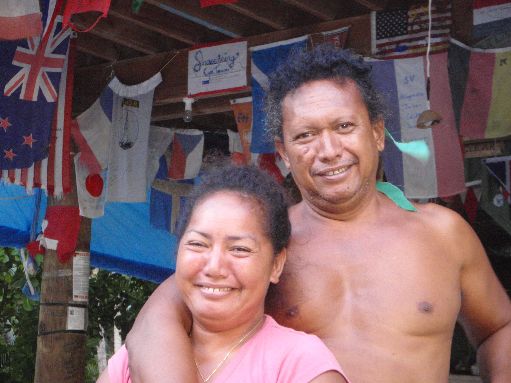 Because they are there for six months at a stretch without re-provisioning, gifts of fresh fruit, veggies or meat are really appreciated. Don’t feel that there’s any requirement to contribute food, but if you do you will likely find fresh fish on your boat from time to time as John is a consummate fisherman. John and Veronica are kind enough to welcome us all into their home to visit, play games, learn about Cook Island life as well as hosting social gatherings for all the boaters. In settled weather John also arranges day trips to the surrounding islands. Veronica is a bit shy but once you get to know her, you’ll never forget her infectious laugh and her kindness. Susan enjoyed learning some local palm frond weaving techniques, especially palm frond boxes.
Because they are there for six months at a stretch without re-provisioning, gifts of fresh fruit, veggies or meat are really appreciated. Don’t feel that there’s any requirement to contribute food, but if you do you will likely find fresh fish on your boat from time to time as John is a consummate fisherman. John and Veronica are kind enough to welcome us all into their home to visit, play games, learn about Cook Island life as well as hosting social gatherings for all the boaters. In settled weather John also arranges day trips to the surrounding islands. Veronica is a bit shy but once you get to know her, you’ll never forget her infectious laugh and her kindness. Susan enjoyed learning some local palm frond weaving techniques, especially palm frond boxes.
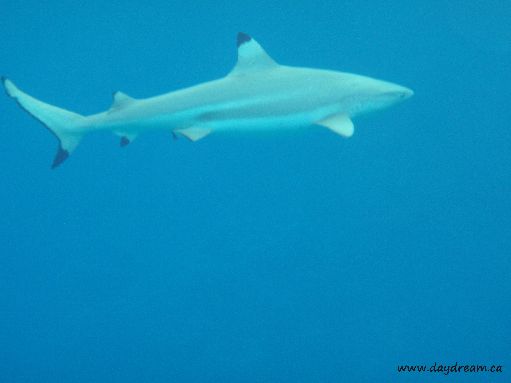 As Suwarrow is a National Park, there are some rules for visitors. The most important rule is “No spear fishing in the lagoon.” This is a rule that John feels very strongly about because there are many sharks in the area and they are instantly drawn to injured fish. Since his kids and visitors like to swim most days, the last thing he wants is a shark attack. In addition, John asks that all fish parts be dumped on the pass side of Anchorage Island, since the sharks like them as well. Most days the kids host a small gut-dumping ceremony at about 5 pm. This is well worth seeing as sharks ranging from two to seven feet boil the surface just a few feet from shore. Usually you’ll see black tips, white tips and a few bigger and more aggressive grey sharks.
As Suwarrow is a National Park, there are some rules for visitors. The most important rule is “No spear fishing in the lagoon.” This is a rule that John feels very strongly about because there are many sharks in the area and they are instantly drawn to injured fish. Since his kids and visitors like to swim most days, the last thing he wants is a shark attack. In addition, John asks that all fish parts be dumped on the pass side of Anchorage Island, since the sharks like them as well. Most days the kids host a small gut-dumping ceremony at about 5 pm. This is well worth seeing as sharks ranging from two to seven feet boil the surface just a few feet from shore. Usually you’ll see black tips, white tips and a few bigger and more aggressive grey sharks.
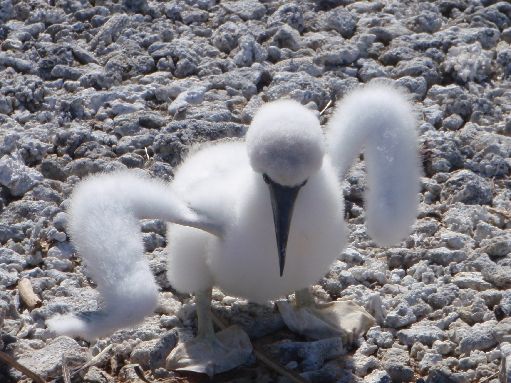 Another of the rules is that you must obtain permission to anchor anywhere except Anchorage island. This anchorage provides good protection in trade wind weather but when we were expecting a blow from the SW, the crews of “Daydream” and “Whisper” asked for permission to move to the Seven Islands area on the East side of the atoll. John asked us to be as careful as possible about the coral, to try not to disturb the nesting birds on the islands and reminded us not to spear fish and then sent us on our way. This turned out to be one of several highlights of our stay although the anchoring was very challenging for a keel boat among the dense coral pillars that rise straight up from 30 feet. The water visibility in this area is approximately 100 feet. The coral formations are the most fantastic we have seen anywhere
Another of the rules is that you must obtain permission to anchor anywhere except Anchorage island. This anchorage provides good protection in trade wind weather but when we were expecting a blow from the SW, the crews of “Daydream” and “Whisper” asked for permission to move to the Seven Islands area on the East side of the atoll. John asked us to be as careful as possible about the coral, to try not to disturb the nesting birds on the islands and reminded us not to spear fish and then sent us on our way. This turned out to be one of several highlights of our stay although the anchoring was very challenging for a keel boat among the dense coral pillars that rise straight up from 30 feet. The water visibility in this area is approximately 100 feet. The coral formations are the most fantastic we have seen anywhere 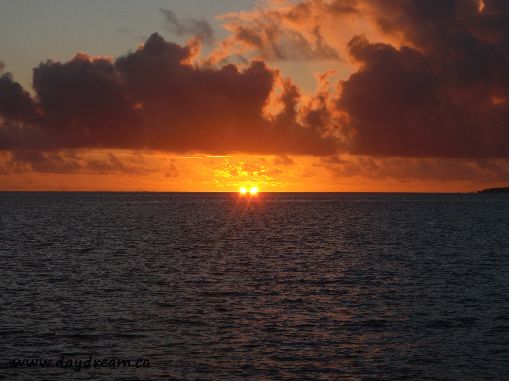 in the world. The fish are friendly and the sharks are timid. So needless to say we enjoyed every minute
in the world. The fish are friendly and the sharks are timid. So needless to say we enjoyed every minute
There’s also an old steel shipwreck on the outer reef near the Seven Islands. The wreck is sitting in about three inches of water at low tide approximately 500 feet from the outer edge of the reef. It’s hard to imagine the power of the waves required to move it that high.
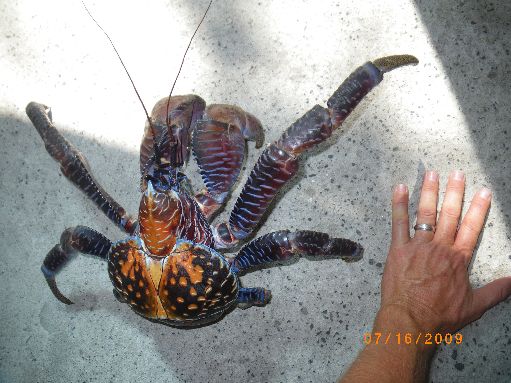 Since they are endangered they are out of bounds for eating, but John and Veronica’s eight year-old twins were happy to find us a coconut crab so that we could take some great photos. These monstrosities are big colorful crabs with pinchers that can break your finger. They look like a wild combination of lobster and crab wearing tie-dye colors. After his photo shoot, we released the crab and he disappeared up a coconut palm in record time.
Since they are endangered they are out of bounds for eating, but John and Veronica’s eight year-old twins were happy to find us a coconut crab so that we could take some great photos. These monstrosities are big colorful crabs with pinchers that can break your finger. They look like a wild combination of lobster and crab wearing tie-dye colors. After his photo shoot, we released the crab and he disappeared up a coconut palm in record time.
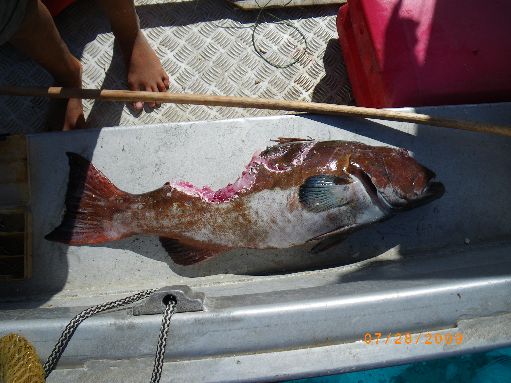 The sharks on Suwarrow have a reputation for abundance which we did experience and aggressiveness which we did not experience. They are however very used to humans in the main anchorage so we normally would have two to six of the black tip reef sharks cruising lazily by the boat. When you went for a swim they tended to let you get a lot closer than normal before they turn away. We didn’t feel threatened but always tried to keep an eye on them. If one headed toward us, we would always swim toward it. We know they can be dangerous, because when the twins caught a fish from the dinghy one of our friendly little sharks took about 5 pounds out of it as a shark-tax before they could get it aboard.
The sharks on Suwarrow have a reputation for abundance which we did experience and aggressiveness which we did not experience. They are however very used to humans in the main anchorage so we normally would have two to six of the black tip reef sharks cruising lazily by the boat. When you went for a swim they tended to let you get a lot closer than normal before they turn away. We didn’t feel threatened but always tried to keep an eye on them. If one headed toward us, we would always swim toward it. We know they can be dangerous, because when the twins caught a fish from the dinghy one of our friendly little sharks took about 5 pounds out of it as a shark-tax before they could get it aboard.
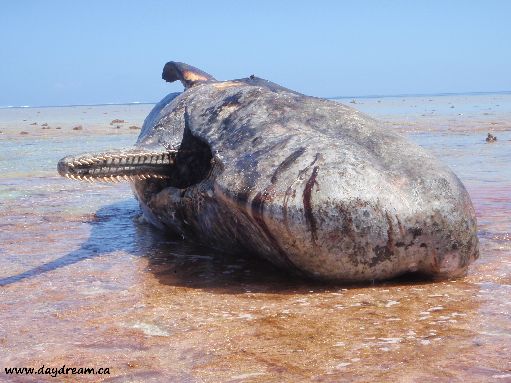 The crews of “Whisper” and “Daydream” were snorkeling near Entrance Island one day when 10-year old Tim from “Whisper” noticed an unusual lump out near the outer reef. After a long slog through knee and thigh deep water across the reef this proved to be a dead sperm whale 51 feet long, by 6 feet wide by almost 10 feet tall. From the condition of the flesh and the fact that the smell wasn’t yet overpowering, it appeared to have been on the reef for about two days. John gave his permission for an attempt to remove the whale’s lower jaw for transport back to Rarotonga. John’s son Jeremiah, Scott from “Whisper” and Wayne from “Daydream” headed out early the next morning with wood saws, fillet knives, an axe and Vicks Vaporub to combat the smell. The stench of rotting whale meat had increased considerably and a large surf coming over the reef constantly threatened to push us under the whale or down its throat but over a period of about seven hours, a significant part of the jaw weighing approximately 250 pounds was cut off. The water around the whale varied from one foot to four feet depending on the tide but for some reason there were no sharks around during the entire bloody operation. However, as Jeremiah pointed out
The crews of “Whisper” and “Daydream” were snorkeling near Entrance Island one day when 10-year old Tim from “Whisper” noticed an unusual lump out near the outer reef. After a long slog through knee and thigh deep water across the reef this proved to be a dead sperm whale 51 feet long, by 6 feet wide by almost 10 feet tall. From the condition of the flesh and the fact that the smell wasn’t yet overpowering, it appeared to have been on the reef for about two days. John gave his permission for an attempt to remove the whale’s lower jaw for transport back to Rarotonga. John’s son Jeremiah, Scott from “Whisper” and Wayne from “Daydream” headed out early the next morning with wood saws, fillet knives, an axe and Vicks Vaporub to combat the smell. The stench of rotting whale meat had increased considerably and a large surf coming over the reef constantly threatened to push us under the whale or down its throat but over a period of about seven hours, a significant part of the jaw weighing approximately 250 pounds was cut off. The water around the whale varied from one foot to four feet depending on the tide but for some reason there were no sharks around during the entire bloody operation. However, as Jeremiah pointed out 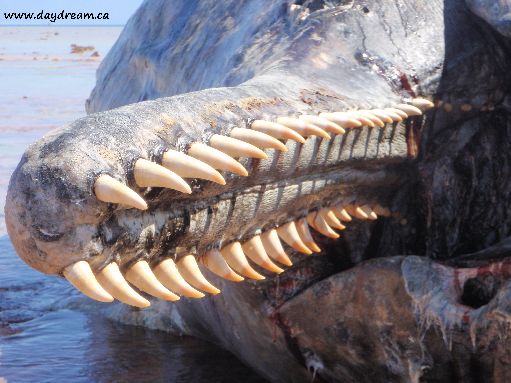 there were shark bites on the whale that had to have happened while it was adrift, leading us to believe that the whale had died prior to grounding on the reef. Returning the jaw to park headquarters at Anchorage island proved much more difficult than expected because the park’s backup boat, an aluminum dinghy named “Boring”, that was carrying it has serious leaks. Between filling up with blood, incoming seawater, the incredible perfume and the near-constant bailing; the four miles motoring back across the atoll was pretty exciting. The jaw is now ashore near the park headquarters and we expect the flesh will rot out over the next several months so that it will be possible for John to return the bones and teeth to Rarotonga at the end of the season. The three of us considered lighting ourselves on fire to burn off the smell but settled for multiple baths instead.
there were shark bites on the whale that had to have happened while it was adrift, leading us to believe that the whale had died prior to grounding on the reef. Returning the jaw to park headquarters at Anchorage island proved much more difficult than expected because the park’s backup boat, an aluminum dinghy named “Boring”, that was carrying it has serious leaks. Between filling up with blood, incoming seawater, the incredible perfume and the near-constant bailing; the four miles motoring back across the atoll was pretty exciting. The jaw is now ashore near the park headquarters and we expect the flesh will rot out over the next several months so that it will be possible for John to return the bones and teeth to Rarotonga at the end of the season. The three of us considered lighting ourselves on fire to burn off the smell but settled for multiple baths instead.
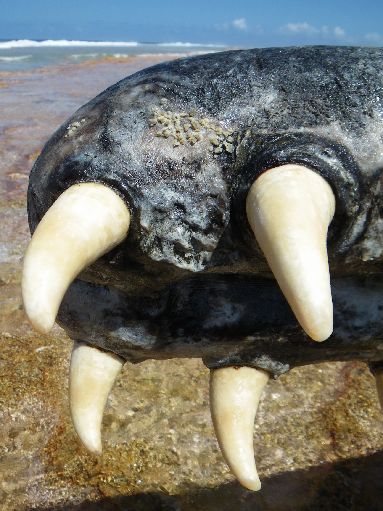 We had originally planned to stay in Suwarrow for a week but one day turned into the next with new and interesting things to do every time we turned around. Somehow over three weeks had sped by. There are still a number of beautiful reefs that we didn’t have time to snorkel and some electrical work on park headquarters that we should have completed, but eventually we were dipping the same onion over and over to make coffee and decided that it really was time to go. It was difficult to leave having become close friends with John and Veronica and their kids and knowing that we are not likely to see them again. We now think that Suwarrow is the most interesting place that we have been to in the South Pacific and recommend it to everyone.
We had originally planned to stay in Suwarrow for a week but one day turned into the next with new and interesting things to do every time we turned around. Somehow over three weeks had sped by. There are still a number of beautiful reefs that we didn’t have time to snorkel and some electrical work on park headquarters that we should have completed, but eventually we were dipping the same onion over and over to make coffee and decided that it really was time to go. It was difficult to leave having become close friends with John and Veronica and their kids and knowing that we are not likely to see them again. We now think that Suwarrow is the most interesting place that we have been to in the South Pacific and recommend it to everyone.
That dead sperm whale was truly spectacular. Imagine a dead animal the size if a city bus, with forty or fifty teeth the size and shape of small elephant tusks.
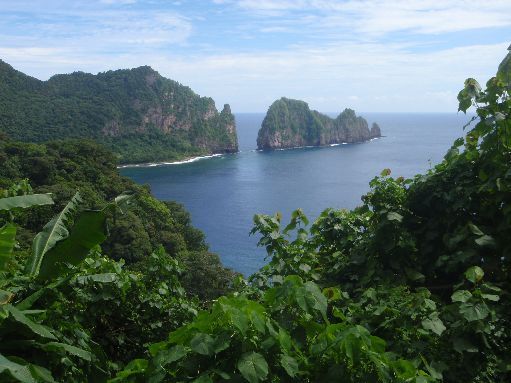 From Suwarrow we made our way to Pago Pago Harbour in American Samoa. Although the island itself is quite beautiful, the harbor itself is a rather grubby place that we only went to in order to access the US Postal system, however we were stuck there for several weeks for a number of reasons. Part of our time was taken up trying to arrange a rescue for a boat that had lost its rudder and had been drifting for four weeks. The couple on board was in no danger but they could not control the boat and so eventually they would run out of food or run up on a reef. Wayne and Scott from “Whisper” walked from government office to government office every day for a week trying to arrange help. We would have thought that the first visit to the US Coast Guard office would have solved it, but their response was a) we don’t have a boat (!!!) And b) its New Zealand’s responsibility unless they get within three miles of US territory(!!!) The harbor master was no better although he did offer to send a tug if needed. We finally found an organization called Marine and Wildlife that has a giant inflatable boat suitable for towing. They were all good people who
From Suwarrow we made our way to Pago Pago Harbour in American Samoa. Although the island itself is quite beautiful, the harbor itself is a rather grubby place that we only went to in order to access the US Postal system, however we were stuck there for several weeks for a number of reasons. Part of our time was taken up trying to arrange a rescue for a boat that had lost its rudder and had been drifting for four weeks. The couple on board was in no danger but they could not control the boat and so eventually they would run out of food or run up on a reef. Wayne and Scott from “Whisper” walked from government office to government office every day for a week trying to arrange help. We would have thought that the first visit to the US Coast Guard office would have solved it, but their response was a) we don’t have a boat (!!!) And b) its New Zealand’s responsibility unless they get within three miles of US territory(!!!) The harbor master was no better although he did offer to send a tug if needed. We finally found an organization called Marine and Wildlife that has a giant inflatable boat suitable for towing. They were all good people who ![]() wanted to help but until we guaranteed that their costs would be paid they couldn’t approve it. Eventually it all came together and when the boat “Avatar” drifted within 14 miles of the island (all the way from Bora-Bora), we went out to get them. “We” included Wayne who talked his way onto the rescue boat. It was a long boring day of towing with many broken tow lines and a certain amount of sea sickness amongst the Marine and Wildlife guys but eventually “Avatar” was safely in. We were trapped in American Samoa for a few more weeks by bad weather but eventually decided that we had to leave. After a very unpleasant trip, we made it to Tonga.
wanted to help but until we guaranteed that their costs would be paid they couldn’t approve it. Eventually it all came together and when the boat “Avatar” drifted within 14 miles of the island (all the way from Bora-Bora), we went out to get them. “We” included Wayne who talked his way onto the rescue boat. It was a long boring day of towing with many broken tow lines and a certain amount of sea sickness amongst the Marine and Wildlife guys but eventually “Avatar” was safely in. We were trapped in American Samoa for a few more weeks by bad weather but eventually decided that we had to leave. After a very unpleasant trip, we made it to Tonga.
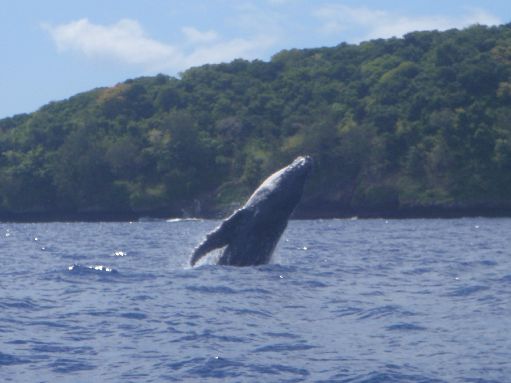 Tonga was our other favorite place. The Vava’u group of islands is super spectacular with clear, calm water, beautiful islands and best of all, hundreds of humpback whales in season. Whales come there to give birth and raise their young for a few months. The Tongan’s have a tourist business of taking people out to swim with the whales. After we had tried on our own with no success, we finally hired a guide. The guide took us and the crew from “Whisper” out in a fast boat and we looked for whales all day. When we found a whale it was always a female with a baby. The baby in this case is the size of a pickup truck and Mom is the size of a greyhound bus. The boat would get close and then we’d go over the side with our snorkels in a mad scramble, swim as hard as we could toward the whales, which would tolerate us for a few minutes then flick their tails and disappear into the deep blue. We each got within a dozen feet two or three times for a few seconds. It was a great experience.
Tonga was our other favorite place. The Vava’u group of islands is super spectacular with clear, calm water, beautiful islands and best of all, hundreds of humpback whales in season. Whales come there to give birth and raise their young for a few months. The Tongan’s have a tourist business of taking people out to swim with the whales. After we had tried on our own with no success, we finally hired a guide. The guide took us and the crew from “Whisper” out in a fast boat and we looked for whales all day. When we found a whale it was always a female with a baby. The baby in this case is the size of a pickup truck and Mom is the size of a greyhound bus. The boat would get close and then we’d go over the side with our snorkels in a mad scramble, swim as hard as we could toward the whales, which would tolerate us for a few minutes then flick their tails and disappear into the deep blue. We each got within a dozen feet two or three times for a few seconds. It was a great experience.
While in Vava’u, a large earthquake occurred between Tonga and Samoa triggering a devastating tsunami in Samoa, American Samoa and Niuatoputapu, the northern island group of Tonga. Many people lost their lives and the damage to property was severe. We were lucky as the effects that we experienced in Vava’u were very minor. We are very thankful that we weren’t still in American Samoa or Nuiatoputapu although our hearts went out to those that live there or were visiting.
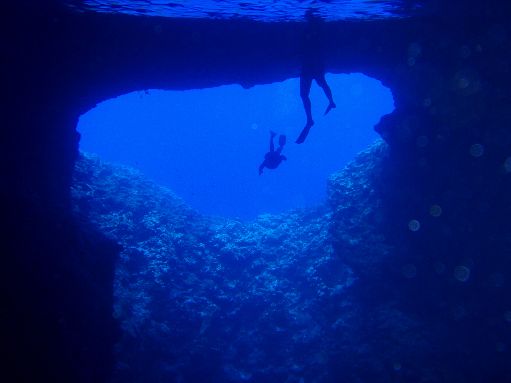 By this time the sailing season was well along. Cyclone season was fast approaching and we had to make a decision. Initially we had planned to head to New Zealand from Tonga like most of the other boats that we had traveled with across the Pacific. However, we had a bit of a glitch in our plans as we found out that New Zealand wouldn’t allow us to leave the boat there for an extended period of time while we went home to Canada. So the decision was made for us and we turned our sights on Australia instead. As we still had thousands of miles to go, we sadly said good-bye to our good friends on “Whisper” and to Tonga and headed to Fiji.
By this time the sailing season was well along. Cyclone season was fast approaching and we had to make a decision. Initially we had planned to head to New Zealand from Tonga like most of the other boats that we had traveled with across the Pacific. However, we had a bit of a glitch in our plans as we found out that New Zealand wouldn’t allow us to leave the boat there for an extended period of time while we went home to Canada. So the decision was made for us and we turned our sights on Australia instead. As we still had thousands of miles to go, we sadly said good-bye to our good friends on “Whisper” and to Tonga and headed to Fiji.
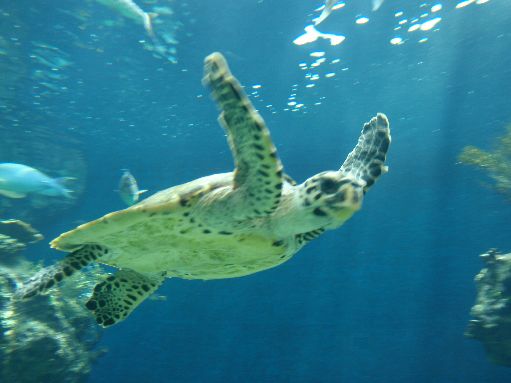 We only had a few days in Fiji and that was in the capital city of Suva. This is definitely not the best way to see Fiji. We’ll have to come back at some point and see some of the other things that Fiji has to offer. Another fast passage and we were in Noumea in New Caledonia. New Caledonia is part of France so it feels like the first world, kind if a shock after the last few months but we were happy to have access to wonderful baguettes again. All too soon we set out on our last passage for the year which took us to Bundaberg in Australia.
We only had a few days in Fiji and that was in the capital city of Suva. This is definitely not the best way to see Fiji. We’ll have to come back at some point and see some of the other things that Fiji has to offer. Another fast passage and we were in Noumea in New Caledonia. New Caledonia is part of France so it feels like the first world, kind if a shock after the last few months but we were happy to have access to wonderful baguettes again. All too soon we set out on our last passage for the year which took us to Bundaberg in Australia.
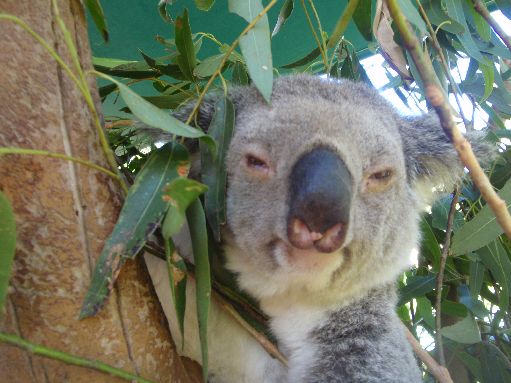 We’ve been here since early November living on a river in front of the town of Bundaberg about ten miles from the ocean. We’ve seen kangaroos in the wild and eaten kangaroo (yummy) from the supermarket. We also went to the Australia Zoo which is Steve Irwin, the crocodile hunter’s, zoo. A bit of a shocker at $110 for two but it was a good day and we saw big crocs, koalas, kangaroo, wombats and cassowary. This last is a huge, weird bird that looks like a dinosaur. We’d like to see a platypus, but they are rare so we’re not holding our breath.
We’ve been here since early November living on a river in front of the town of Bundaberg about ten miles from the ocean. We’ve seen kangaroos in the wild and eaten kangaroo (yummy) from the supermarket. We also went to the Australia Zoo which is Steve Irwin, the crocodile hunter’s, zoo. A bit of a shocker at $110 for two but it was a good day and we saw big crocs, koalas, kangaroo, wombats and cassowary. This last is a huge, weird bird that looks like a dinosaur. We’d like to see a platypus, but they are rare so we’re not holding our breath.
We plan to store the boat for a while here in Australia and fly home to Canada in February.
For the first time we had an underwater camera along and we put it to good use. Don’t miss out on seeing some of this year’s photos especially the ones from Suwarrow. There are more photos to come from New Caledonia, Fiji and Australia so keep checking back. To see more photos from our adventures in the South Pacific click here.
